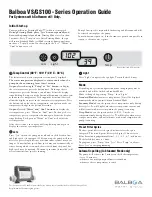
49
EN
4.1
Switching the appliance on
Before connecting the appliance, make
sure that the wiring is correct and that
the water heater is full of water. The
water heater comprises an adjustable
thermostat that regulates the water
temperature. The pilot remains lit while
the heating element is operating and
heating the water.
4.2
Emptying through the
safety valve
It is normal that when the water heater
is heating the water, the pressure
increases, the water expands and if
this pressure cannot be absorbed by
the system, it must be vacated. This is
done through the safety valve hole, thus
preventing the excess pressure from
remaining inside the water heater.
4.3
Adjusting the
temperature
m
WARNING
Being able to adjust the
temperature with the
thermostat means we can
optimise energy use depending
on our comfort demands.
In any case, it is advisable
not to store water at a very
low temperature to prevent
legionella.
We recommend the following:
– The temperature of the water inside
the water heater must be greater than
50º.
– In case of extended absence, before
using it again, set the thermostat
to the maximum temperature for at
least 24hrs. Empty the water from the
water heater at different points and at
different times.
– Keep taps and showers free from
limescale.
The lever on the protective cover can
be used to adjust the temperature of
the thermostat upwards or downwards
depending on whether a higher or lower
temperature is desired.
4.4
Safety limiting
components
The electric water heater is equipped
with a dual safety thermostat in line with
current European standards.
The safety system is triggered in the
event water is abnormally overheated,
which then automatically switches off
the power supply to the heating element.
In this case, a small button will pop
out. To reset the thermostat and return
it to operation, you need to press the
small button that has popped out with a
pointed object.
4.5
External cleaning
Clean the outer shell with a cloth and
mild soaps, never with organic-based
solvents or abrasive products (alcohol,
gasoline, turpentine, etc.).
4.6
Checking the effective-
ness of the safety valve
The safety valve needs to be checked
regularly to avoid excess pressure within
the tank, which could damage the tank’s
enamel, and this will also allow safe use
of the appliance. When checking, remove
any limescale deposits that may have
formed over time.
4
OPERATING INSTRUCTIONS








































